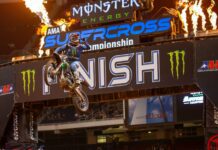A grand jury will determine if Tony Stewart will be charged in Kevin Ward Jr.’s death. The District Attorney for Ontario County, N.Y., said Tuesday he would submit evidence from last month’s fatal sprint car crash to the grand jury.
Stewart struck and killed Kevin Ward Jr. during a sprint car race Aug. 9 at Canandaigua Motorsports Park.
No timetable was given for when the grand jury will hear evidence in Stewart’s case. A spokesman for Stewart-Haas Racing confirmed that Stewart will race this weekend at New Hampshire Motor Speedway.
The Ontario County Sheriff’s office announced Thursday it had completed its investigation in the incident and that the District Attorney’s office would determine what action to take.
Michael Tantillo, Ontario County’s District Attorney stated: “Upon my review of all of the information contained in the entire investigation, I have made the determination that it would be appropriate to submit the evidence to a grand jury, for their determination as to what action should be taken in this matter. Accordingly, the evidence developed in the investigation will be presented to an Ontario County grand jury in the near future.
“As grand jury proceedings in New York State are strictly confidential by law, I am unable to state when the matter will be scheduled, other than to state that I intend to present the matter in the near future. Similarly, because of the confidential nature of these proceedings, I cannot state who will be called as witnesses, or what any witness’s expected testimony will be. When the presentation has been completed and a determination has been made, I will advise the public and the media at that time of the results.’’
Tantillo has been the county’s district attorney since 1989. He won a seventh term in 2013, running unopposed. Each term is four years.
Stewart issued a statement Tuesday afternoon, saying: “I respect the time and effort spent by both the Ontario County District Attorney and the Sheriff’s Office in investigating this tragic accident. I look forward to this process being completed, and I will continue to provide my full cooperation.”
NASCAR has not sanctioned Stewart for this incident even though its Rule Book includes a section on “Behavior Penalties.” The section states: “With the privilege comes certain benefits, responsibilities and obligations. Correct and proper conduct, both on and off the race track is part of a Member’s responsibilities. A Member’s actions can reflect upon the sport as a whole and on other NASCAR members. … Therefore, NASCAR views behavior rule, violations with the same importance as technical rules violations.’’
The section also states that NASCAR handles behavior infractions on a “case-by-case basis.’’ NASCAR lists penalties for behavior infractions as ranging from probation to termination of membership.
Brett Jewkes, NASCAR’s chief communications officer issued a statement in regards to the Tantillo’s decision to take evidence to a grand jury: “We are aware of the completed investigation and the announced next steps. First, our thoughts continue to be with all who have been impacted by this tragedy. We will monitor this process and stay in close contact with Stewart-Haas Racing. It would be inappropriate for NASCAR to comment on this case so we will continue to respect the process and authorities involved.”
As the case heads to a grand jury, what will happen next?
A grand jury decides if a person should be formally charged with a crime or other offense based on evidence presented by the prosecutor. A grand jury does not determine if a person is guilty of a crime.
The defense does not present any evidence in this setting. A defense attorney is present only if the accused person chooses to testify. The defense attorney is not permitted to ask questions, make objections or speak to the grand jury.
A grand jury can indict an individual based on the evidence presented, moving the matter to trial. The grand jury also can vote to dismiss the charges. Or, the grand jury may direct the prosecutor to file a lesser charge against a person charged. Should the grand jury dismiss charges, the prosecutor can come back at another time with more evidence.
A typical grand jury features 23 jurors. At least 16 jurors must be present and at least 12 must agree on a course of action. All of this is done in secret. Grand jurors may ask witnesses questions about the evidence. Grand jury witnesses are not required to keep their role secret. Witnesses are allowed to discuss their testimony in public if they wish to do so.


















































